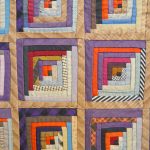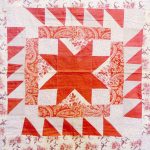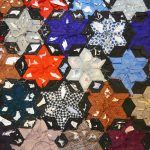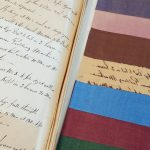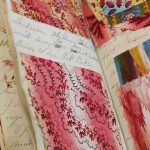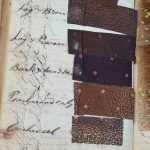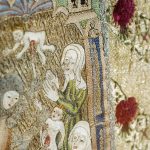This log cabin patchwork is believed to have been used as a ‘carriage rug’. Carriage rugs were made from thick, warm materials and were draped over the knees and legs whilst travelling in a carriage to help protect against chills and draughts. The many overlapping strips of fabric used to make log cabin patchwork create […]
View moreThis small patchwork coverlet is probably a cot cover and has been made by piecing without paper templates. The design has a frame layout, where concentric borders frame a central panel. Squares, strips and triangles have been used to create several different borders including examples of the patterns ‘tree everlasting’ or ‘flying geese’ and saw […]
View moreThis unfinished patchwork is made using the English paper piecing technique. Diamond shaped papers have been covered with fabric and arranged into a pattern of colourful stars formed by six diamonds within a framework of darker diamonds. The covered paper shapes are joined together by overcast or whip stitching. The design effectively uses high contrast […]
View moreThis is a commercial sample of a type of fabric known as ‘madras’, which at the time this fabric was produced referred to a lightweight cotton with a woven check. The check could form an all over pattern, as seen in this example, or it could be woven as borders or in stripes with plain […]
View moreThis book comes from Rosebank Mill in Lancashire and dates from 1832. The inside cover features the name Bennet Greig and the name of the mill and the date 25th September 1832. It contains an array of printed dress and furnishing fabrics along with detailed notes about their production. Within the pages are examples of […]
View moreThis book contains mostly printed cotton dress fabrics with a few examples of larger scale prints labelled as ‘furnitures’, which would have been used as household furnishings such as upholstery or curtains. Many of the fabric samples showcase the adoption of innovative new developments in printing technology from the early 19th century. One of the […]
View moreThis book comes from Rosebank Mill in Lancashire and contains samples of mainly dress fabrics. Most of the samples are printed on smooth, evenweave cotton although there is one sample of cotton with a ribbed pile like corduroy. The cover bears the name Thomas Comstive and indicates that the book covers the period “1832 and […]
View moreIn 1982 the Harris received a bequest from a local lady who had recently passed away. Miss Mabel Haythorn (born 1910) lived in an apartment in Frenchwood House in Preston her whole life. We believe she never married and had a private income. In her will, she left the Harris Museum & Art Gallery a […]
View moreIn 1982 the Harris received a bequest from a local lady who had recently passed away. Miss Mabel Haythorn (born 1910) lived in an apartment in Frenchwood House in Preston her whole life. We believe she never married and had a private income. In her will, she left the Harris Museum & Art Gallery a […]
View moreIn 1982 the Harris received a bequest from a local lady who had recently passed away. Miss Mabel Haythorn (born 1910) lived in an apartment in Frenchwood House in Preston her whole life. We believe she never married and had a private income. In her will, she left the Harris Museum & Art Gallery a […]
View moreThe Whalley Abbey Vestments are a set of exquisitely embroidered Medieval ecclesiastical garments with the full set comprising of a chasuble, two dalmatics and a maniple. Of these, the chasuble, maniple and one dalmatic are in the collection of Towneley Hall, while another matching dalmatic resides in the Burrell Collection in Glasgow. These vestments are […]
View moreThese suits acted as a protective layer that would cover visitors own clothing whilst they enjoyed the Fun House at Blackpool Pleasure Beach. They take the form of a robust cotton overall in geometric, colour blocked panels in brown, pink, green and yellow. the cuffs have a contrasting yellow button at each wrist and a […]
View more